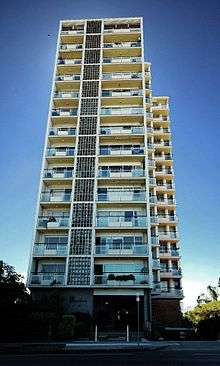Torbreck home units

The Torbreck Home Units were the first high-rise and mix-use residential development in Queensland, Australia. These heritage-listed home units are located at 182 Dornoch Terrace, Highgate Hill, Brisbane. Designed by architects Aubrey Job and Robert Froud (Job and Froud Architects), construction began in 1957 and was completed three years later in 1960. The project acquired the name 'Torbreck' to recognise a small, gabled timber cottage that previously occupied the site (called Torbreck).[1]
Description
Torbreck is a soft-modernist high-rise building, located between Dornoch Terrace and Chermside Street, on approximately 6,521m2 (70,191.5 sq. feet) of land. The building itself covers approximately 1,749.15m2 of land (18,827.7 sq. feet), with 150 individual units, totalling 19,892.78m2 in floor area.[2] It consists of two adjoining components: an eighteen storey, south-facing Tower Block, and a long, narrow, eight storey north-facing Garden Block. The former features panoramic views of Brisbane city, while the latter overlooks a landscaped garden and communal swimming pool.[2] The immediate surrounds are well vegetated, with the plants providing shade for the outdoor living areas and car park. Each unit in Torbreck has at least one balcony, which include planter boxes and glass balustrades. Torbreck is constructed from concrete and brick, with expressive detailing in brickwork, stone and timber, to address the domestic scale.The development was originally designed to provide social and public amenity with a mix-used ground floor, having facilities such as shops and restaurants, these were never built.[3]
Climatic design
Job and Froud saw it important that each apartment carefully considered privacy, outlook and proper orientation. These principles, coupled with the trend towards passive climatic design that was popularised in Queensland by Karl Langer, resulted in a design that strongly incorporated passive design principles.[3] As well as informing Torbreck's planning, technologies such as the innovative aluminium vertical blade sun shading system were incorporated to manage breezes, solar heat and glare impact and maximise the use of natural light within the building. The significance and attention given to external garden spaces further demonstrates the significance of the climate and place of Brisbane as design drivers.[2]
Construction
Origins
The design project and planning began in 1957 at the request of Rowley Pym and progressed quickly due to his enthusiasm. The capital used to fund construction was drawn from pre-sales of units, prompting an unprecedented level of media attention to the tower. The project was considerably rushed, encountering many financial difficulties and administrative errors. Torbreck Kratzman Pty Ltd., the company formed to build the apartments declared bankruptcy prior to the construction of the tower block, and the project was sold to Reid Murray Developments in 1959, which consequently went into liquidation before the project was completed.[3]
Construction techniques
Both blocks demonstrate a different approach to concrete construction, the garden block being a relatively standard example of a reinforced concrete structure of the late 1950s, while the tower block employed the new ‘lift slab construction' system, the first of its kind in Queensland. The term lift-slab defines a style of construction in which each floor, and the roof are pre-fabricated on the ground in a stack and raised into position along vertical wall supports.[4] The external walls are cavity brick and provide an aesthetically domestic cladding for the building, as well as providing insulative properties. Internal walls dividing apartments were of a double brick construction to reduce sound transfer, while walls within apartments were of a non-load bearing nature to allow for simple future renovations.[2]
Media coverage
Though initially Torbreck was only designed so far as a single perspective sketch, the project drew headlines, due to intense publicity efforts of developer Row Pimley.[5] As the first high-rise residential project in Queensland, Torbreck received a considerable amount of public interest and media coverage throughout its inception and construction. It made several headlines from October 1957, to 1960, when construction was completed and residents began moving in. Public response and interest in the project was greater than anything earlier in Brisbane's history.[3]
Heritage listing
Torbreck was added to the Queensland Heritage Register on 17 December 1999.[6]
See also
References
- ↑ Wilson, Andrew. "Life Cycle: Torbreck". Architect. Australian Design Review. Retrieved 03/10/12. Check date values in:
|access-date=(help) - 1 2 3 4 Kai, Charmaine (2006). "Subtropical Design Multi-Unit Dwelling Case Study: Torbreck Home Units" (PDF). Centre for Subtropical Design. Retrieved 07/10/12. Check date values in:
|access-date=(help) - 1 2 3 4 Ferguson, Susan (1997). The Residential Design Legacy of R. P. Froud (Thesis). Brisbane, Australia: The University of Queensland.
- ↑ "Novel Building Method for Torbreck" (PDF). Telegraph (Brisbane). 10/09/1958. Retrieved 05/10/2012. Check date values in:
|access-date=, |date=(help) - ↑ "£750,000 Block of "Home Units"" (PDF). Sunday Mail. 1957-10-27. Retrieved 05/10/12. Check date values in:
|access-date=(help) - ↑ "Torbreck (entry 601256)". Queensland Heritage Register. Queensland Heritage Council. Retrieved 10 January 2014.
Further reading
- Ferguson, Susan (1997). The Residential Design Legacy of R. P. Froud (Thesis). St. Lucia, Australia: The University of Queensland.
- De Gruchy, Graham (1988). Architecture in Brisbane. Bowen Hills, Australia : Boolarong Publications with Kookaburra Books.
External links
- Torbreck Home Units
- Torbreck (Your Brisbane: Past and Present)
- Subtropical Design Multi-Unit Dwelling Case Study: Torbreck Home Units
- Persepective image of Torbreck
- Sample contemporary project within Torbreck Home Units
- Torbreck: Brisbane
- Torbreck Home Units collection at the University of Queensland, UQFL426
Coordinates: 27°29′13″S 153°01′05″E / 27.48701°S 153.01792°E